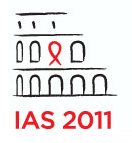More metabolic abnormalities in children receiving a PI compared to NNRTI in NEVEREST study
1 August 2011. Related: Conference reports, Paediatric care, Side effects, IAS 6th Rome 2011, Paediatric Workshop 3 Rome 2011.
 Polly Clayden, HIV i-Base
Polly Clayden, HIV i-Base
NEVEREST was a study in which young children who were exposed to nevirapine as PMTCT and initiated on PI-based HAART were randomised to continue on this regimen or switch to a nevirapine based regimen (we report the final results from NEVEREST later in this issue of HTB).
NEVEREST investigators evaluated body composition and metabolic abnormalities in 156 children exiting the trial. The objectives were to compare lipid profiles, markers of inflammation and regional fat distribution in children receiving a PI-based regimen of LPV/r plus 3TC plus d4T to those switched to an NVP-based regimen. [1]
The childrens weight (kg) and height (cm) was measured and weight-for-age, height-for-age and BMI-for-age z-scores (WAZ, HAZ, BAZ) calculated. Fasting total cholesterol (TC), high density lipoprotein (HDL), low density lipoprotein (LDL), triglycerides (TG), C-reactive protein (CRP), viral load, absolute CD4 and CD4 percentage were obtained. Circumferences and skinfolds were also measured; waist to hip ratio (MWC:MHC) and skinfold sum (SFS) were calculated. Upper arm and thigh fat estimates (UFE, UTFE) were calculated by Rolland Cachera. Analyses were intent to treat.
At the time of analyses, children were a mean age of 5.1 (range 3.6 6.9) years and approximately half were boys; 85 (42 boys) were randomised to the PI arm and 71 (40 boys) to the NNRTI arm. There were no differences between the two groups in sex, age, total time on ART, time since randomisation, WAZ, HAZ or BAZ or proportion with viral load <50 copies/mL. But children in the NNRTI group had a higher CD4 count, 1480 cells/mm3 compared to 1356 cells/mm3, p=0.049.
The investigators found differences in metabolic measurements. Mean TC was greater in the PI group, 171 (SD+39) mg/dL vs 161 (SD±31) mg/dL, p=0.05 as was the proportion of children with hypercholesterolemia (TC >200 mg/dL), 18.8% vs 8.5%, p=0.03. They also observed lower mean HDL levels, 51 (SD±14) mg/dL vs 59 (SD±16) mg/dL, p=0.006 and higher mean LDL levels, 100 (SD±34) mg/dL vs 88 (SD±27) mg/dL, p=0.018, in the PI group. The mean TG level was also greater in the PI group, 94 (SD+39) mg/dL vs 72 (SD±29) mg/dL, p<0.001 as was the proportion with hypertriglceridemia (TG >150 mg/dL), 12.9% vs 2.8%, p=0.038.
The children in the PI group had significantly greater amount of total body fat compared to those receiving an NNRTI, with a mean SFS of 43 (SD±11.1) mm vs 39 (SD±10.1) mm, p=0.029 and % body fat by BIA (Horlick Equation) of 0.17 (SD±0.7) vs 0.14 (SD±0.08), p=0.042.
The percentage of fat in the upper arm did not differ between groups but the percentage of fat in the upper thigh was greater in the PI group, p=0.021. Also the PI group had a smaller ratio of trunk fat relative to thigh fat, p=0.03.
The investigators wrote: These unfavourable alterations in lipids and lipoproteins are of great concern with respect to potential increase in long term CVD risk and should be considered in treatment strategies, such as the reuse of NNRTIs for NNRTI-exposed infants.
References
Shiau S et al. Body composition and metabolic abnormalities of perinatally HIV-infected children in South Africa on long-term ARV treatment. 3rd International workshop on HIV paediatrics. 15-16 July 2011. Rome, Italy. Oral abstract O_2. Also presented at the 6th IAS Conference on HIV pathogenesis, treatment and prevention. 17-20 July 2011. Rome, Italy. Poster abstract 252.

